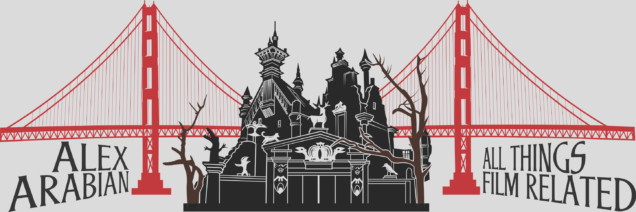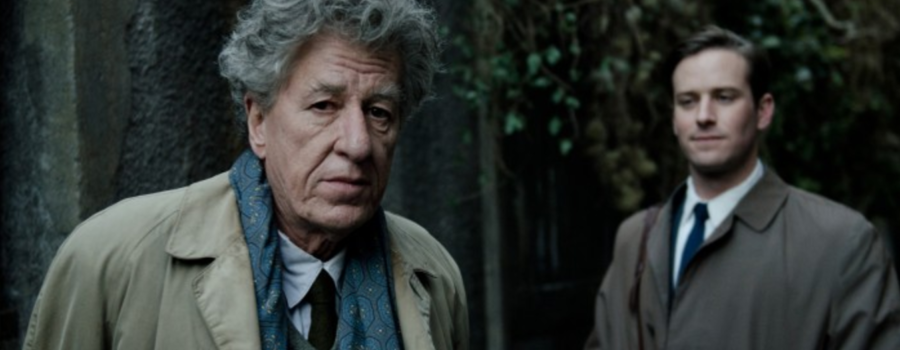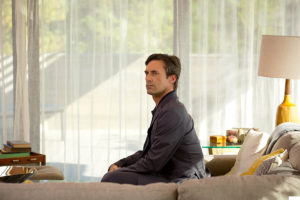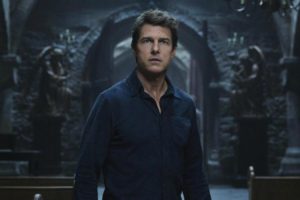 [Published on Awards Circuit] 2017 Berlin International Film Festival: Actor and filmmaker Stanley Tucci (“Big Night,” “The Lovely Bones”) undertakes his fifth directorial effort with “Final Portrait,” a film about Alberto Giacometti (Geoffrey Rush), the esteemed and eccentric Swiss painter and sculptor. Based on James Lord’s biography, “A Giacometti Portrait,” the film follows Lord (Armie Hammer), an art critic, as he is personally asked to fly to Paris to pose for Giacometti, offering a unique glance into the life of a genius in his natural habitat.
[Published on Awards Circuit] 2017 Berlin International Film Festival: Actor and filmmaker Stanley Tucci (“Big Night,” “The Lovely Bones”) undertakes his fifth directorial effort with “Final Portrait,” a film about Alberto Giacometti (Geoffrey Rush), the esteemed and eccentric Swiss painter and sculptor. Based on James Lord’s biography, “A Giacometti Portrait,” the film follows Lord (Armie Hammer), an art critic, as he is personally asked to fly to Paris to pose for Giacometti, offering a unique glance into the life of a genius in his natural habitat.
Giacometti is bold, confident, neurotic and almost maniacally sharp, playing to Rush’s strengths as an actor. Rush takes on this role with as much dedication as he gave throughout the film “Quills,” in which he plays The Marquis de Sade, another eccentric and boundary-pushing real-life artist. In fact, the two real-life historical figures share many traits, including their misogyny and how they provoke and push societal boundaries. Giacometti lives a bohemian and bourgeoisie lifestyle simultaneously, as he makes a fortune off his works of art which he hides in his studio, his sanctuary of madness and artistic brilliance. He decides his own schedule, when to work and when to play, living a life of leisure with purpose. His relationship with his wife Annette (Sylvie Testud) is tested because of his protectiveness of his earnings and the fact that he focuses more attention on his mistress, Caroline (Clémence Poésy). His relationship with his brother, Diego (Tony Shalhoub in his second feature film collaboration with off-screen friend Tucci since Fox Searchlight’s “The Imposters,” and, more notably, “Big Night”), his artistic collaborator and moral support, is also unique because Diego has learned to accept his brother’s oddities, quirkiness and sheltering of his personal life.
Casting director Nina Gold struck gold, pun intended, with this cast, providing Tucci with more than enough talent to work with and bring out beautiful performances from the talented cast. Lord observes everything about Giacometti, writing down each detail, providing the groundwork of what would become Giacometti’s biography. Giacometti’s daily routine is as follows: he goes out and parties with his prostitute lover, Caroline, late into the night, returns to his workshop and creates, and then proceeds to sneak in bed with his wife in the morning. It seems exhausting, but this is how he functions. Giacometti’s doubts and proclamations of how a portrait can never be finished alarms Lord, who constantly reminds him that he needs to return to New York.
As Lord spends time with Giacometti, he realizes the aforementioned eccentricities are going to extend his time with the seminal artist, causing him to postpone his flight several times. This serves as a comedic yet essential aspect to providing insight into Giacometti’s process as an artist. The two often get sidetracked by Giacometti’s aloofness, frequenting the cafe, social functions and long walks through the cemetery. The film is at its best when these moments alone with Rush and Hammer allow for mutually introspective realizations and revelations, building their unique relationship. Tucci understands the importance of the two main characters’ connection, and lets these moments in the cemetery or at the cafe linger, allowing Rush and Hammer to build an electric onscreen chemistry.
It is during the small moments in the film between Lord and Giacometti that we finally hear the artist articulate his opinion about art. He proclaims Cezanne the greatest painter to ever live, and even calls Brach and Picasso frauds and copycats. To provide historical context, Giacometti’s work is heavily influenced by Paul Cezanne, who was inspired by the movement of impressionism in painting which began in the 1880s by Renoir. Impressionism evolved into pointillism, characterized by the style of brush stroke, which evolved into Cubism, a movement indirectly founded by Cezanne which was indeed expanded by Pablo Picasso. Furthermore, Paul Brach was influenced by Pablo; the history of art, just like the history of time, repeats itself and recycles old material to add a new perspective. Giacometti criticizes his predecessors as much as he romanticizes them. He lives in the past, hence the reason why he holds so dear his older works of art and is disregarding and bitter about his newer works that are making him a fortune.
Over the course of the film, Lord also builds a relationship with Diego, whom he relates to because of their mutual frustration with Giacometti as an artist. Lord comes to realize that Diego was sucked into Giacometti’s world, his loyalty remaining strong, and that Diego has a sculpting talent of his own that he has kept at bay. Even while being overshadowed by his brother, Diego does not seem to mind; he goes with the flow, even eventually helping Lord wrap up this 18-day journey as a kind gesture to both Lord and Giacometti.
As the film progresses, we see Giacometti lose sight of what is most important to him: his art. He is distracted by Caroline’s alluring nature, her disappearance and reappearance, and his fear of losing his oldest, most dearest works of art to lithographers, who tell him his paper is too old for the process to transfer onto stone. Though she is his muse and unhealthy obsession, Caroline ultimately deters Giacometti from his work. After getting sick, Caroline’s pimps rummage through and destroy some of Giacometti’s works of art as a warning. In a moment of self-actualization, he pays off the pimps for Caroline’s services and focuses his newfound attention singularly on Lord’s portrait.
After many “failures” to capture Lord’s portrait over the course of two weeks, Lord gives Giacometti a deadline of four days, as advised by Diego, to which Giacometti agrees. Each day, Giacometti undoes the portrait created because he feels he can never live up to the standards he has set for himself. Lord, realizing a pattern, finally conjures a plan to stop Giacometti at the precise moment before he destroys the painting. This works, and finally, Giacometti reluctantly gives Lord his final portrait, as this would be his last prolific work before his death shortly after. The portrait was sold last year for $20,000,000. Though Giacometti was fond of their experience and craved more time with Lord, even telling him to visit again, the two never saw each other for the rest of their respective lives.
There is a recurring theme of the importance of art preservation, and, by proxy, that of history. Art was once the only means of capturing a person’s image, long before photographs. Art is also a form of telling history, just as film is. Yet, painting is a dying art form, and Giacometti expresses his grief of this unsavory fact. It is also what fuels his doubts and neuroticism. There is also a theme of both misogyny and the complexity of love, marriage and relationships. Giacometti cheats on his wife and ignores her when he pleases, yet she also cheats on him, and, for the most part, they are both okay with this concept. They have grown accustomed to each others’ lifestyles, a concept that Lord does not seem to wrap his mind around until the third act.
In every aspect, “Final Portrait” is a perfect film. Tucci has been conceiving this project since his twenties, so he had time to craft the exact film he wanted. Every single shot, even if it came out of improvisation, was intentional and directed with a calculating precision. Much like Jackson Pollock’s abstract expressionist approach to painting, Tucci makes every blemish created by his extemporized directorial style deliberate. He explained at the Berlinale press conference that he wanted the color palate to be muted. Knowing it was a period piece, he did not want to create a sepia or black and white color palate seen in so many period pieces, but rather a realism with natural lighting. Giacometti’s workshop is a dungeon, yet as soon as they leave for the cafe, we see spark in color, contrasting perfectly what occurs both inside the artist’s head and also in the world around him. Furthermore, along with his director of photography Danny Cohen, Tucci had two handheld cameras the entire film, providing an intimate setting for their actors and allowing for more creative perpetuation and evolution during the filmmaking process. Tucci has undoubtedly evolved as a director since “Big Night,” 21 years ago, even after a 10-year hiatus.
It is wonderful to see Shalhoub and Tucci collaborating again. As a director, Tucci encourages spontaneity. He urges his actors to make things up, and Rush and Hammer were both more than up to the task. As Hammer explained, working with Rush was like playing tennis with a world class, professional Grand Slam winner. Although “Final Portrait” is a film about perfectionism as portrayed through Giacometti, Tucci emphasized that he wanted to convey a chaos, paralleling the artist’s artistic process. At the same time, Tucci explained he knew when to stop, when the scene had come to a natural close, much unlike the film’s central character. As such, the point of the abrupt yet beautiful ending of the film is that the painting of the portrait within the film ends because it had to end. Otherwise Lord and Giacometti would have been working on the portrait forever. Although everyone in the audience could have watched another three hours at least, judging by the overwhelming applause at the Berlinale Palast as the credits rolled, to extend the story would be revisionist history. Viewers should expect a delightful viewing experience filled with passion, humor and heartfelt sincerity.
“Final Portrait” is produced by Olive Productions, Potboiler Productions and Riverstone Pictures. The film had its Berlinale debut on Feb. 11, and has yet to have a worldwide release date set.
GRADE: (★★★★)








Leave a Reply
Your email is safe with us.